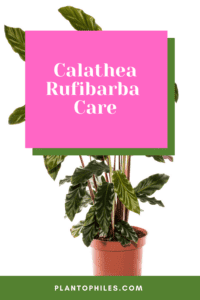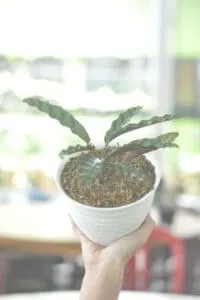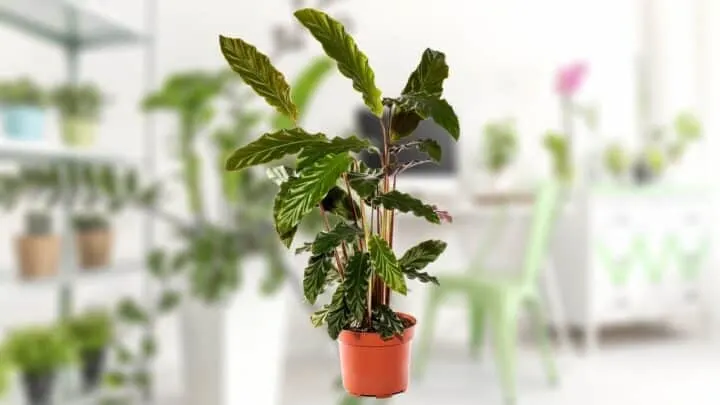Calatheas are a stunning family of houseplants.
Most varieties feature bi-colored leaves where the tops are various tones of greens and the bottoms reveal a deep purple color.
Aesthetically, they make an amazing addition to any houseplant collection by adding some color that will stand out amongst the sea of green.
Calathea rufibarba, also known as fuzzy feathers plant or velvet Calathea, is particularly interesting because of the textured, fuzzy feel on the underside of the leaves.
During the blooming season, large yellow flowers will peak under the foliage exhibiting a surprising splash of color.
Should you bring home a Calathea, special attention must be taken to keep them in tip-top shape.
They can be finicky about soil moisture and humidity, but once you find the right balance of humidity they forgive quickly and will bounce back.
Calathea Rufibarba Care
To care for Calathea rufibarba use a well-draining potting mix consisting of potting soil, compost, coconut coir, and vermiculite or perlite. Water every 5 days once the top 1” of soil is dry (2.5cm). Provide bright indirect light and a temperature between 64-73 degrees Fahrenheit (18-23 degrees Celsius) and humidity above 60%. Fertilize by-weekly in spring and summer using a liquid fertilizer high in nitrogen.

Calathea rufibarba Care
Calathea rufibarba Care Guide
Soil
The ideal soil for Calathea rufibarba is a well-draining potting mix using potting soil, compost, coconut coir, and vermiculite or perlite.
The perfect soil for Calatheas is a well-draining mix full of organic matter.
I know it can be confusing to read that the soil should both retain the water and drain it out.
This essentially means that the soil should absorb a good amount of water while easily releasing the excess.
For example, super-compact soils with high amounts of clay won’t drain out excess water. Instead, they become wet and muddy – a nightmare for houseplants.
The opposite would be a soil mixture that is too high in sand or perlite.
This sort of medium will quickly drain out most of the water and you’ll be left with dry soil (meaning you’ll have to water it much more often).
To achieve the perfect balance between water-retaining and well-draining soil make your own mix or select a bagged mix that specifies Calatheas on the package.
To make your own, mix equal parts of:
- Potting soil
- Compost
- Coconut coir
- Vermiculite or pearlite
The compost and coconut coir will retain water while the vermiculite and perlite will give enough space between soil particles for excess water to drain.
Watering
Water Calathea rufibarba every 5 days or so as a general rule of thumb once the top 1” of soil is dry (2.5cm).
The biggest care requirement for Calatheas is frequent watering.
They like moist soil without being too wet or with puddles on the surface.
While other houseplants need only be watered once a week or once every two weeks, water your Calathea every 5 days or so.
This will depend on the size of the pot, the season, temperature, and ambient humidity.
To test whether it’s time to water, stick your finger into the surface of the soil.
If the top inch is dry (2.5cm), it’s time to water. If the top few inches are dry, don’t wait so long to water next time.
Plants that require frequent watering can become susceptible to root rot from overwatering.
Overwatering only becomes a serious problem if it continues for a long time, so keep an eye out for early warning signs.
Another big thing to keep in mind is to use filtered water for your Calathea.
Hard, tap water has a lot of added substances like chlorine, which will cause damaged foliage.
Your Calathea will show you it’s unhappy through yellowing or browning in the leaves, slower than normal growth, and sad droopy-looking foliage.
Because Calatheas can be so picky with their watering preferences, I highly recommend using a self-watering pot.
These are designed to provide the plant with a steady stream of moisture, so you don’t have to worry about filtering and watering your plant every couple of days.
If you opt for a self-watering pot, you must be sure to routinely maintain it as it can stop working properly or become a source for disease.
If you already have a pot you want to use or aren’t convinced by the self-watering models, make sure it at least has a drainage hole at the bottom.
Without drainage holes, your soil will not be able to expel excess water and your Calathea will surely develop root rot.
Light
Provide bright indirect light for a Calathea rufibarba.
In the wild, Calatheas are usually found in the shaded and humid forest understory.
Replicate these conditions in your own home by placing your velvet Calathea away from direct sunlight.
Temperature
Calathea rufibarba grows best in a temperature between 64-73 degrees Fahrenheit (18-23 degrees Celsius).
It will survive temperatures down to 59 degrees Fahrenheit (15 degrees Celsius).
If the temperature is too cold, your plant will tell you through damage to its leaves.
These temperatures are consistent with average indoor temperatures. Keep your home at a comfortable temperature for you and your houseplants will be happy.

Calathea rufibarba grows best at a temperature between 64-73 degrees Fahrenheit (18-23 degrees Celsius)
Humidity
The ideal humidity level for Calathea rufibarba is 60% or higher.
Calatheas are humidity-loving plants and will not tolerate low humidity.
Strategies for keeping the air around Calatheas humid include:
- Placing them near other plants to take advantage of the microclimate.
- Setting up a humidifier near the plant.
- Placing the pot on a tray with clay pebbles and water (make sure the pot doesn’t touch the water though).
You can also try misting the plant daily, but it’s a lot of trouble, not very effective, and promotes disease.
Brown leaves indicate the plant is too dry.
If you see the foliage turning brown, it’s time to check the soil moisture and ambient humidity.

Calathea rufibarba enjoys high humidity levels above 60%
Fertilizer
Fertilize Calathea rufibarba in spring and summer using a liquid fertilizer high in nitrogen every two weeks.
Calatheas have specific timeframes for fertilizing and are very sensitive to over-fertilizing.
Make sure to mark your calendar so you don’t forget and take care to not exceed the recommended amounts.
Only feed your fuzzy feather plant during its growing season in the spring and summer and completely stop feeding it during autumn and winter.
To fertilize in the spring and summer, add some liquid fertilizer high in nitrogen to the water every two weeks to encourage healthy growth.
Organic fertilizers are less likely to burn the delicate roots if you accidentally overdose.
Repotting
Calathea rufibarba is a slow grower and will only reach about 24 inches in height (60cm).
This means you only have to repot your Fuzzy Feather plant every two years – an excellent perk for busy plant parents.
If you want to propagate your Calathea repot it during the growing season in spring and summer. Should you just need a bigger pot, any time of the year will do.
To repot your velvet Calathea you will need a new pot that is a few inches bigger than the one it’s currently in with proper drainage, appropriate soil mix I reviewed above, and water.
Make sure the pot is only a couple of inches bigger because your houseplant will suffer if it has too much space.
First, water your plant the day before to facilitate removing the plant from its current home.
Then you’ll want to pull it out from the base. Once the plant is out of the smaller pot tease the roots carefully so they untangle.
I find it helps to shake it gently to get the excess soil off. You can do this over the new pot to take advantage of the soil.
Add more soil mix to the container so it goes up to about halfway. Next, use your hand to create a small crater in the center to accommodate the roots.
Place the Calathea in its new home and fill the rest of the pot with soil. Gently press down on the top of the soil or tap the bottom of the top on the ground so the soil settles.
Finish off by watering thoroughly and then getting rid of the water from the dish below.
Now sit back and enjoy as your beautiful plant fills out the container over the next two years.
Pruning
One of the best parts of Calathea maintenance is that you can prune it at any time of year.
Yellow leaves will fall off naturally, but you can also prune them off.
Actively pruning yellow leaves will also help you grow a thriving plant. It will spend less energy maintaining the dying leaves and will focus on putting out new growth.
This is particularly important when repotting, so you’ll want to get rid of dying foliage during the repotting process.
Propagation
Propagate Calathea rufibarba in the spring and summer months by division, while it is growing.
Propagation is done by division since seeds are incredibly hard to come by. Take advantage of repoting to propagate your plant.
Follow the same first steps you would to repot.
When the Calathea is out of the pot and you’ve untangled the roots cut the stem without roots.
Place this cutting in fresh potting soil in a different pot and water it thoroughly.
Keep the container with the stem in a dark, humid place until it takes root.
Once it starts showing new growth, treat it as you would any other velvet Calathea.
Blooms
Calathea rufibarba will sometimes surprise you by putting out subtle yellow blooms that peek out beneath the leaves.
It isn’t very common when they’re grown indoors, but keep an eye out for buds coming out of a central stalk.
Common Problems with Calathea Rufibarba
The most common problems I’ve found with Calatheas include getting enough humidity, hard tap water, inconsistent watering where the soil dries out completely, and intense air currents from air conditioners or heaters.
Yellow or Brown Leaves
The most common issue faced by Calathea owners is browning or yellowing leaves.
This happens when the soil is too wet or too dry, there isn’t enough humidity, or it’s getting direct sunlight.
Brown or yellow leaves are most frequently a sign of incorrect watering. Should this happen, increase the frequency of watering, set up a humidifier, and prune away the damaged leaves.
Brown leaves can also be a symptom of too much sunlight. If your plant is getting direct light, shield it by surrounding it with sun-loving plants or move it away from the window.
Not enough sunlight
A common problem with Calatheas is owners not giving them enough sunlight.
Although they do not like direct sun, they do enjoy bright indirect light. Hiding them away in a dark corner will cause faded and droopy foliage.
Make sure your velvet Calathea is in a bright room with plenty of sun, but not in the direct path of the light.
Pests – spider mites and mealybugs
When Calatheas are not in their ideal conditions and struggling, they can be susceptible to small pests like spider mites and mealybugs. These sneaky insects can easily be wiped away with a cloth dipped in soapy water.
Healthy houseplants are very resistant to pests, so the most important preventative care is to keep your plants thriving.
Tips for Growing Calathea rufibarba
Pests and diseases are not very common for Calatheas, so keeping your plant happy depends mostly on watering and high humidity.
Follow these essential tips to keep your Calathea happy and growing:
- Keep the soil moist but not wet by using the correct soil mix and a pot with good drainage.
- Hard water will damage the leaves, so using filtered water is best.
- Place the pot in a place with bright indirect light.
- Calatheas are slow growers, so give it fertilizer high nitrogen once a month during the growing season in spring & summer.
- If you are using a self-watering pot check on it frequently to make sure it’s working correctly.
Frequently asked questions about Calathea rufibarba Care
Can I water my Calathea with tap water?
It depends on your tap water, but usually no. Tap water normally has chlorine and other additives that will remain in the soil and affect your plant. Water your fuzzy feathers plant with filtered water or water that has been sitting out for a few days.
Why are my Calathea leaves a weird color?
Brown or yellow leaves can be a symptom of incorrect water or light. Adjust your watering habits and light conditions accordingly until you find a nice balance.
Are velvet Calatheas really fuzzy?
The underside of Calathea leaves feels fuzzy to the touch.
Conclusion About Calathea rufibarba Care
If you’re looking for a houseplant that will add a splash of color to your home, look no further than Calathea rufibarba.
Not only will the purple stand out, but it also has a fuzzy texture that is just delightful to pet.
Keep your fuzzy feathers plant thriving by paying attention to the watering and humidity needs.
If you sometimes forget to water or are often away from home, I strongly recommend using a self-watering pot (you can thank me later).

Daniel has been a plant enthusiast for over 20 years. He owns hundreds of houseplants and prepares for the chili growing seasons yearly with great anticipation. His favorite plants are plant species in the Araceae family, such as Monstera, Philodendron, and Anthurium. He also loves gardening and is growing hot peppers, tomatoes, and many more vegetables.


